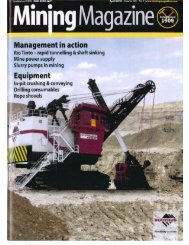clamp-on, sonar-based volumetric flow rate and gas ... - CiDRA
clamp-on, sonar-based volumetric flow rate and gas ... - CiDRA
clamp-on, sonar-based volumetric flow rate and gas ... - CiDRA
Create successful ePaper yourself
Turn your PDF publications into a flip-book with our unique Google optimized e-Paper software.
Count<br />
30000<br />
24000<br />
18000<br />
12000<br />
6000<br />
0<br />
HIGH<br />
0% 5% 10% 15% 20%<br />
0%<br />
Flomeko 2005<br />
6 – 9 June 2005<br />
100%<br />
80%<br />
60%<br />
40%<br />
20%<br />
Cumulative<br />
Count<br />
10000<br />
8000<br />
6000<br />
4000<br />
2000<br />
LOW<br />
100%<br />
80%<br />
60%<br />
40%<br />
20%<br />
0<br />
0%<br />
0% 5% 10% 15% 20%<br />
Figure 5: Frequency distributi<strong>on</strong> of the relative offset of s<strong>on</strong>ar versus mag meter.<br />
series of reverse flotati<strong>on</strong> cells. As in this specific example neither meter was “nulled” relative<br />
to the other, either the high density histogram or the low density histogram may be used as a<br />
reference for the other. It follows that the difference between the two meters, s<strong>on</strong>ar <strong>and</strong> an<br />
electromagnetic, has shifted by about 5% with the change in the magnetite c<strong>on</strong>centrati<strong>on</strong>.<br />
This is believed to be due to the fact that the calibrati<strong>on</strong> of the electromagnetic <strong>flow</strong>meter is<br />
dependent <strong>on</strong> the actual c<strong>on</strong>centrati<strong>on</strong> of magnetite in the <strong>flow</strong>. A <strong>flow</strong> meter that is not<br />
affected by the detailed make up of the fluids <strong>flow</strong>ing <strong>and</strong> any particulates therein is a very<br />
clear advantage. It is to be noted that in other comparable cases, where n<strong>on</strong> magnetic<br />
particulate material is suspended in the <strong>flow</strong>, the difference between s<strong>on</strong>ar <strong>and</strong> an<br />
electromagnetic <strong>flow</strong> meter is not affected by the density.<br />
4 MEASUREMENT OF GAS CONTENT<br />
Using a similar, <strong>and</strong> in many cases the same, hardware platform it is also possible to<br />
measure the velocity of sound of acoustic waves propagating in the process piping. The<br />
propagati<strong>on</strong> of acoustic waves occurs at frequencies much above the frequency domain of<br />
vortical pressure fluctuati<strong>on</strong>s, therefore the same s<strong>on</strong>ar processing can be applied to<br />
determine both the acoustical velocity <strong>and</strong> the voritical velocity at the same time. The relati<strong>on</strong><br />
between speed of sound in twophase mixture <strong>and</strong> the <strong>volumetric</strong> phase fracti<strong>on</strong> is well known<br />
in case the wavelength of sound is larger than the pipe diameter <strong>and</strong> hence also significantly<br />
larger than any process in homogeneities such as bubbles.<br />
4.1 Velocity of sound in liquid/<strong>gas</strong> mixtures<br />
The mixing rule 12 , known as Wood’s equati<strong>on</strong> 13 , expresses the fact that in a mixture the<br />
compressibility of the mixture equals the <strong>volumetric</strong>ally averaged compressibility of the pure<br />
comp<strong>on</strong>ents. For the mixture density a similar rule holds: the mixture density equals the<br />
<strong>volumetric</strong> average of the pure comp<strong>on</strong>ent densities. Because the velocity of sound in a fluid<br />
equals the square root of the compressibility over the density, the two mixing rules can be<br />
written as:<br />
1<br />
c<br />
2<br />
<br />
<br />
c<br />
g<br />
g<br />
2<br />
g<br />
1<br />
<br />
<br />
c<br />
2<br />
l l<br />
( 1<br />
)<br />
<br />
Here, φ is the volume fracti<strong>on</strong> of <strong>gas</strong> at line c<strong>on</strong>diti<strong>on</strong>s, c is the speed of sound, ρ the density<br />
<strong>and</strong> the subscripts g <strong>and</strong> l refer to the <strong>gas</strong> <strong>and</strong> liquid phase respectively. Figure 6 illust<strong>rate</strong>s<br />
the relati<strong>on</strong> between mixture sound speed <strong>and</strong> <strong>gas</strong> c<strong>on</strong>tent for an air water mixture. In most<br />
industrial processes, at mode<strong>rate</strong> temperature <strong>and</strong> pressure line c<strong>on</strong>diti<strong>on</strong>s, the<br />
compressibility of the <strong>gas</strong> phase is orders of magnitude larger than the compressibility of the<br />
liquid phase. Inversely, the density is dominated by the liquid density. As such, it will be<br />
necessary to measure the process pressure (when varying) as both the <strong>gas</strong> density <strong>and</strong> the<br />
BI0197 RevB 6<br />
l<br />
(4).<br />
Cumulative



